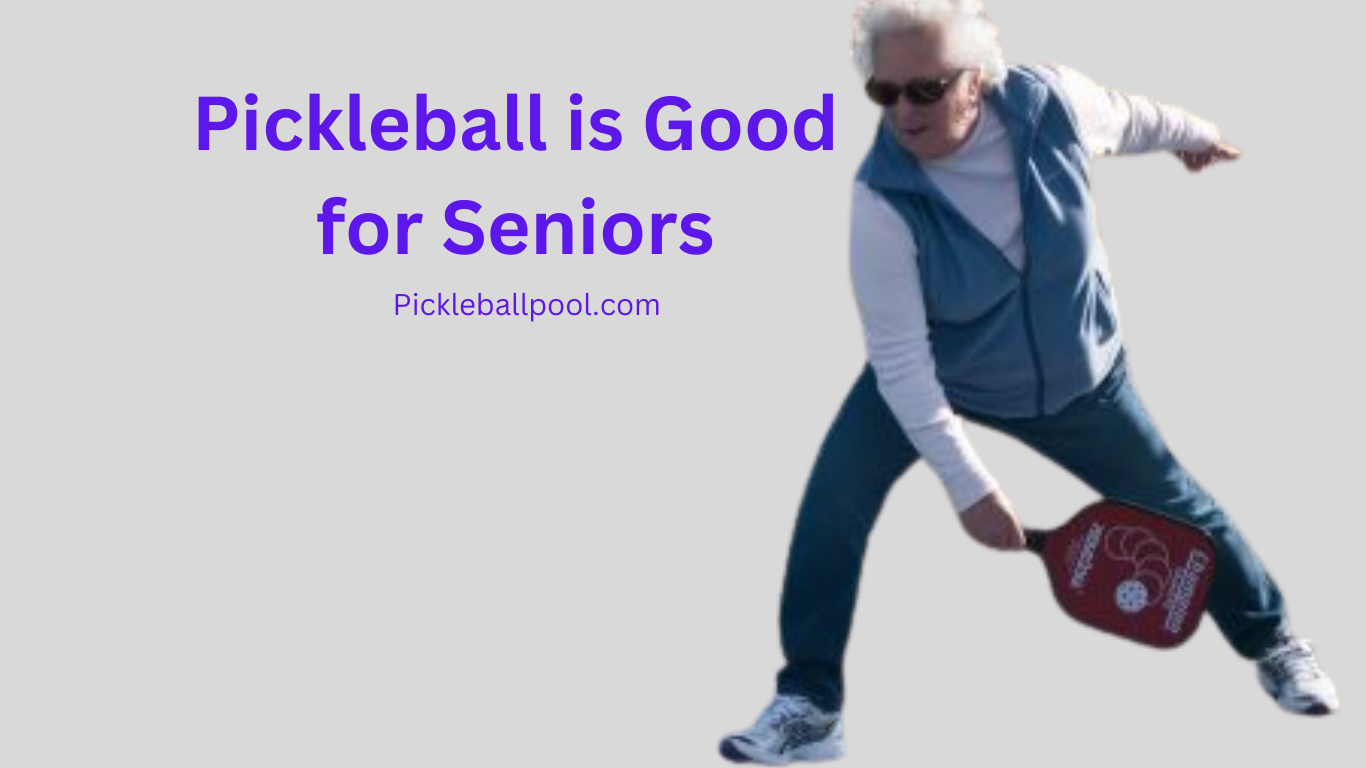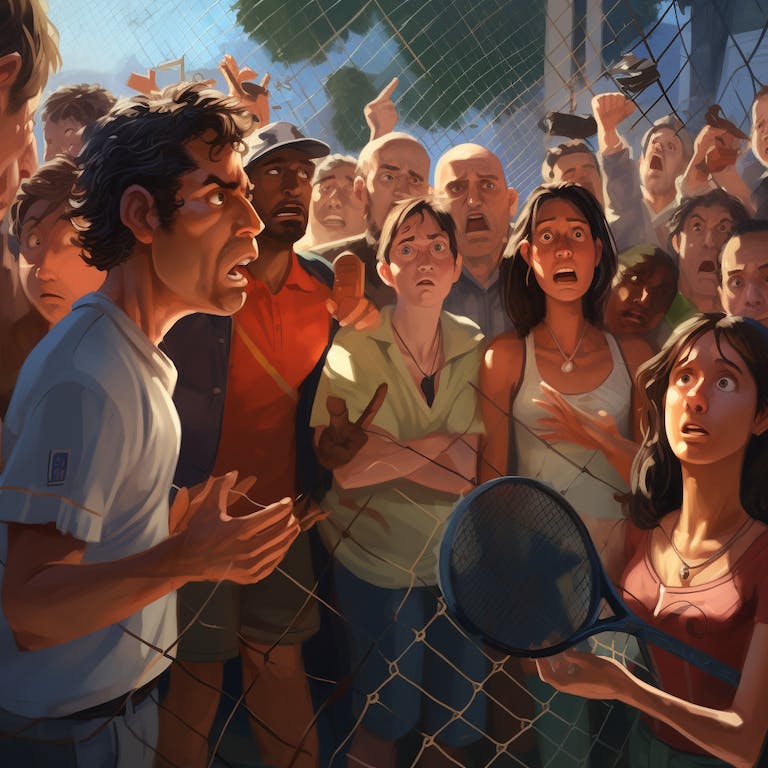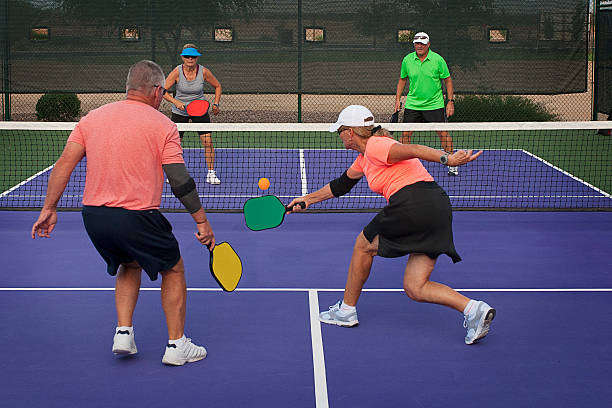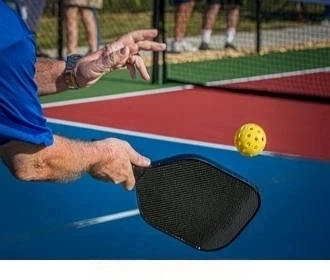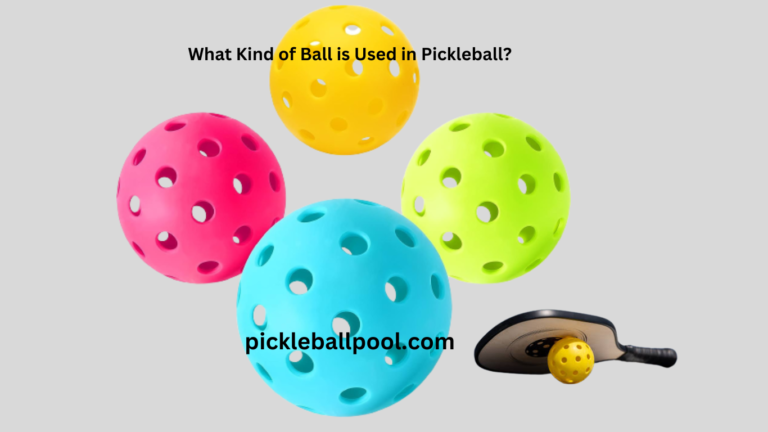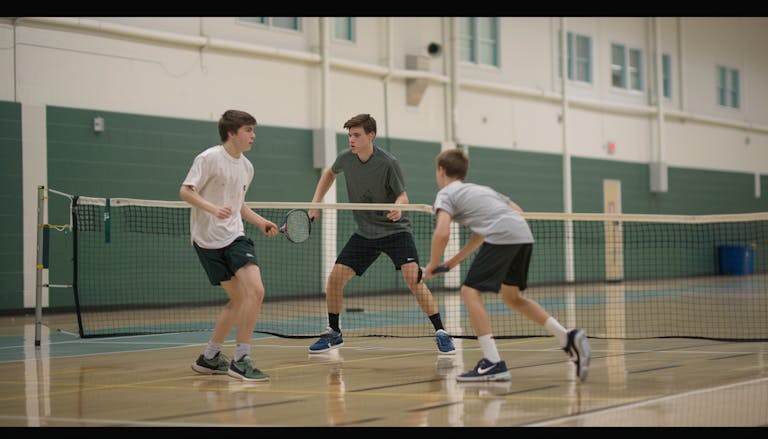The Complete Guide to Pickleball for Seniors
Pickleball has exploded in popularity among seniors in recent years. The sport combines elements of tennis, badminton, and ping-pong into a fun game that provides excellent exercise.
Pickleball is easy to learn, provides a gentle workout, and allows for socializing and competition. For active older adults, pickleball delivers countless physical and mental benefits. This comprehensive guide covers everything seniors need to know about getting started with pickleball and improving your game.
What is Pickleball?
Pickleball is a racket sport played on a badminton-sized court with a lowered net. Matches are played as doubles or singles. It combines aspects of tennis, badminton, and table tennis. Players use solid paddles to hit a plastic, perforated ball over the net and score points as opponents fail to return the ball.
Courts have specific pickleball lines and a non-volley “kitchen” zone that prevents aggressive shots at the net. The game has relatively simple rules and equipment needs, making it easy for beginners.
Pickleball was invented in the 1960s and derived its funny name from the creator’s dog,, Pickles who chased stray balls. It has soared in popularity in retirement communities and across North America, with an estimated 4 million players today. The USA Pickleball Association calls it “one of the fastest growing sports in America.”
With that growth, dedicated pickleball courts, leagues, tournaments, and lessons are now widely available for seniors looking to take up the sport. And many find it a great way to have fun, move more, and make friends in their golden years.
Why Seniors Love Pickleball
There are many excellent reasons pickleball has become a sensation among older adults:
- It provides a fun, social activity that gets seniors moving and interacting with others. The game facilitates exercise, skill development, and friendly competition.
- It is low impact and gentler on aging joints than other racquet sports like tennis. The smaller court reduces running distance. Games often feature more volleys than groundstrokes, minimizing impact.
- The simple rules and equipment make pickleball very easy to learn, even if you’ve never played racquet sports—basic skills like serving, volleying, and scoring come quickly.
- It accommodates all skill levels. Novice and experienced players can enjoy friendly games and find appropriate competition.
- Minimal strength or mobility is required thanks to the lightweight paddles and plastic balls. The game emphasizes finesse over speed and power.
- It provides a good cardiovascular workout and improves balance and reflexes – essential for senior fitness. Games involve frequent starting/stopping and direction changes.
- Most courts accommodate wheelchair access, opening the sport up to seniors with disabilities.
With so many advantages tailored to seniors, it’s easy to see why pickleball is thriving among the 55+ crowd.
Health Benefits of Pickleball for Seniors
Beyond being a fun pastime with friends, regular pickleball provides many valuable health benefits for seniors:
- Cardiovascular exercise: The aerobic activity and exercise duration in pickleball helps seniors maintain heart health and endurance.
- Muscular strength & endurance: Pickleball improves overall muscle and core strength in the legs, arms, and core required for consistent hitting, movement, and balance during active games.
- Flexibility: The reaching, swinging, and lunging involved in pickleball improves balance and flexibility, which gradually declines with age.
- Hand-eye coordination: Quick reactions and hand-eye coordination are essential in pickleball to track and hit the ball effectively, helping sharpen seniors’ reflexes.
- Mental stimulation: Learning rules and strategies plus focusing during active games provides cognitive challenges to help keep the mind sharp.
- Social connectedness: Playing and interacting with others forms strong social bonds and community, combating risks of isolation and depression.
- Stress relief: Exercise and friendly competition provides an outlet to reduce stress and anxiety levels.
Pickleball checks almost every box for a senior fitness activity that enjoyably enhances both physical and mental health.
Pickleball Gear Essentials for Seniors
One of the most accessible sports to get started in, pickleball requires minimal equipment:
- Paddle – Also called a racquet or racket, the main piece of gear is the solid paddle used to hit the ball. Look for lightweight paddles from around 7-10 ounces to reduce arm strain. Composite materials like fiberglass or graphite are ideal for control. Longer grip handles of approximately 5 inches help absorb impact.
- Balls – Pickleballs have holes like wiffle balls and are made of durable plastic polymer. They weigh about the same as a standard tennis ball but measure 3 inches in diameter.
- Court shoes – Any athletic shoes with good traction and lateral support work well. Look for cushioned soles and midsole support. Lightweight mesh or leather shoes allow ventilation and comfort during active games.
- Comfortable clothing – Loose athletic shorts, tops, and layers allow freedom of movement while playing in any season.
That’s all you need as a senior beginner. Of course, there are more advanced paddles, shoes, and gear to upgrade over time. Fancier equipment is optional, especially when first learning the game.
Ideal Pickleball Court Layout for Seniors
Pickleball courts are designed specifically for the game’s unique mix of elements from tennis, badminton, and ping-pong. Here are the key components that make them senior-friendly:
- Smaller playable area measuring 20×44 feet – about 1/3 the size of a tennis court. Less running distance and a smaller overall surface compared to tennis.
- Lowered net height at 36 inches at the ends and 34 inches in the middle. More accessible for older players to reach and hit balls.
- Defined kitchen area – Non-volley zone extending 7 feet from the net. Prevents fast volleys and aggressive shots up close.
- Dedicated pickleball lines – Separate from tennis markings. Lines indicate unique court layouts and scoring zones.
- Even, accessible surface – Most courts paved in asphalt or sport court tiles allow wheelchair access.
- Adequate safety zones – Courts have space around boundaries to retrieve balls and avoid obstructions.
The official pickleball court specifications purposefully adapt areas like size, net height, and layout to create an easily accessible court environment suited for players of all ages and mobility levels.
Pickleball Formats for Seniors
Pickleball is most commonly played in the doubles format, but singles and mixed doubles also offer variety.
Doubles Play
Doubles pickleball teams consist of two players on each side. The Doubles are the most popular format among seniors for several reasons:
- Allows socializing and camaraderie with a partner
- Partners can cover more court space and find strengths/weaknesses balance
- Longer rest between volleys since two players
- Less running distance than singles
Doubles emphasizes shot placement strategy over speed. Features more volleys at the net. It gives players a chance to rest while their partner hits, a nice perk for older players.
Singles Play
Singles pickleball is one-on-one, providing more opportunities for moving and hitting. Benefits for senior singles players:
- Excellent for improving mobility and conditioning
- All shots are your responsibility
- Emphasizes skill variety from lobs to drop shots
- Provides rigorous mental workout tracking all balls
Singles are more demanding physically but accelerate all-around skill improvement. Jumping into dollars, play should be built up to fitness-wise.
Mixed Doubles
Mixed doubles teams feature one male and one female player on each side of the net. Doubles offers:
- social aspect of the game
- Opportunity to play with a spouse or partner
- Interesting male vs. female matchup on the court
- Chance to play with a variety of partners
The mixed team format keeps the game fresh and provides a welcome change of pace from standard men’s, or women’s league doubles play.
Pickleball Dinking Strategy for Seniors
Dinking in pickleball involves gently tapping the ball just over the net into the opponent’s non-volley kitchen zone. For seniors, a linking strategy has several advantages:
- Allows control of ball speed and placement
- Draws opponents up to the net into your control zone
- Reduces strain of running/power hitting from the baseline
- Provides time to get back into a defensive position
- Opens up chances for offensive drop shots
Drinking puts your opponents on their toes. Seniors can exhaust and manipulate foes with this Pickleball Gambit using control and finesse over power. Patience and consistency are key – avoid going for winners. Simply keeping the ball in play and moving opponents can win points.
Avoiding Pickleball Injuries As a Senior
For most seniors, pickleball provides a gentle path to staying active. However, some injury risks do exist to be aware of:
- Muscle strains – Warming up and stretching before play helps prevent muscle pulls in areas like hamstrings, shoulders, and lower back. Proper post-game stretching aids recovery too.
- Joint pain – Arthritis and tendonitis can flare up with repetitive pickleball motions. Using proper technique, limiting consecutive play days, and cross-training help.
- Fall risks – Fast starts/stops on the court can lead to slips or falls, especially on wet surfaces. Proper footwear provides needed traction.
- Fatigue – Aggressively competing with younger or highly skilled players can be overly fatiguing. Know your limits and take breaks when tired.
- Eye injuries – Although rare, eye safety glasses can protect against hits from fast-moving pickleballs.
Especially for beginners, taking it slow, using appropriate gear, and warming up/stretching thoroughly helps make pickleball participation safe and enjoyable. Feel free to sit out points or games as needed.
Pickleball Courts and Places to Play Near Me
The pickleball craze has fueled significant growth in courts and play locations across North America. Here are some ways to find pickleball near you:
- Local parks & rec centers – Call your county and city rec department to find public pickleball courts and playing times.
- Schools & community centers – Check elementary, middle school, high schools, and community centers which often open facilities for public recreation.
- Churches – Many churches, especially larger ones, have dedicated pickleball courts and playing groups.
- 55+ Communities – Retirement village developments almost always have pickleball courts and clubs. Guest policies allow public play.
- Online directories – Websites like pickleballlife.com and places2playpickleball.com list places to play by state.
- Private pickleball clubs – Larger metro areas often have paid pickleball clubs. Day passes provide court access.
With massive growth, pickleball courts and resources can be found across most cities and towns. Seek out both public and private facilities to maximize playing options.
Tips for Learning Pickleball As a Beginner Senior
Here are some critical tips for senior novices starting with pickleball lessons and learning the game:
- Take entry-level group lessons at local rec centers or private clubs to learn basics like rules, scoring, footwork, and strokes.
- Upgrade to small group or private lessons for faster skill refinement with customized instruction.
- Focus initial lessons on key fundamentals like the serve, dink, volley, groundstrokes, and court positioning. Master these building blocks first.
- Use a lighter-weight paddle around 7 ounces, to start. It reduces fatigue and allows you to swing the paddle head faster as you build hand-eye coordination.
- Work on consistent ball control before trying to overpower shots. Keeping the ball in play is more important early on than speed or tricky shots.
- Play cooperatively during lessons and practice rather than competitively. Rally with partners and focus on form versus points.
- Vary partners to experience different playing styles. You’ll improve quicker playing with better players too.
With the correct instruction and fundamentals-first focus, seniors can progress steadily in pickleball, even if starting from scratch. Patience and repetition develop skills and confidence.
Pickleball Drills and Exercises for Seniors
Beyond just playing games, dedicated drilling is essential for seniors to improve critical pickleball skills. Helpful solo and partner drills include:
Serving practice – Work on accurately placing serves deep into the backcourt and on the sidelines to limit opponent returns. Practice spin serves.
Dinking consistency – Stand close and dink back and forth with a partner, focusing on ball control and placement versus speed or power.
Drop shot mastery – Set up close to the net and drill well-placed drop shots that clear the net outside your partner’s reach.
Volley precision – Volley with a partner concentrating on quick reaction time, keeping volleys deep, and directional control.
Groundstroke repetition – Trade topspin forehand and backhand groundstrokes with a partner from the baseline to build reliable groundstrokes.
Overhead smashes – Slam balls fed by a partner over the net and inbounds to work on aggressive swinging volley technique.
Ladders – Hop back and forth over a ladder pattern on the court to enhance foot quickness and direction-changing skills.
Dedicated practice of essential pickleball skills elevates seniors’ play. Repetition develops muscle memory. Have fun creating and naming new drills!
Pickleball Classes, Camps, and Lessons for Seniors
From beginner lessons to intensive camps, pickleball instruction explicitly tailored to seniors is widely available:
Local rec center classes – Park district and county rec centers often offer affordable pickleball group lessons on rules, scoring, volleying, and serving.
Private club coaching – Larger pickleball clubs employ experienced instructors for private or small group lessons to refine skills.
Adult education programs – Local school districts frequently offer pickleball instruction through community education and senior center programs.
Resort/retirement community camps – Active adult resorts and 55+ communities host multi-day camps covering strategy, skills training, live play, and more.
Online lessons – Websites like PickleballTutor.com provide paid video lesson packages for home practice on fundamentals, drills, and tactics.
Instruction from experienced pickleball teachers helps seniors correct bad habits, advance skills quicker, and play more enjoyably against appropriately matched competitors. Lessons are a wise investment for quicker improvement.
Pickleball Gear and Equipment Essentials for Seniors
Essential gear senior pickleball players should have included:
Paddle – Opt for lightweight composite or fiberglass paddles from 7-10 oz. Larger grip circumferences around 4.5-5 inches are easier to hold for older hands.
Court shoes – Cushioned cross trainers or court shoes provide needed support. Look for lateral stability and quick stops/starts.
Comfortable clothing – Light, loose athletic wear allows movement while managing sweat and temperature regulation.
Knee pads – Compression knee sleeves reduce strain and absorb impact on aging joints.
Pickleballs – Indoor and outdoor balls have differences. Start with 3-star balls before upgrading to higher-bounce indoor balls.
Water bottle – Stay hydrated before, during, and after play.
Grip tape – Add grip tape to paddles for more traction and handling.
Investing in quality equipment tailored to seniors’ needs enhances comfort, playability, and safety on the courts.
Pickleball Tournaments for Seniors
Pickleball’s rise has fueled massive growth of competitive tournaments for ambitious senior players:
Local club competitions – Join a club team! Local clubs hold in-house tournaments, ladder leagues, and round robins.
Regional tournaments – Cities and metro areas host 1-day and weekend games with varying age and skill brackets.
State & regional games – Senior Games associations like the Florida Sunshine State Games hold major regional pickleball competitions.
National senior championships – The gold standard, like the USAP National Senior Games, brings high-level competitors together.
Pro tournaments – Prime events like the US Open Pickleball Championships allow amateurs to play with pros.
Traveling to significant events combines competition with exploring new places. Local club tournaments offer an easy intro to competition. Matching your skills, fitness, and experience level keeps senior tourneys fun.
Is Pickleball Good Exercise for Seniors?
Absolutely! Consider its excellent fitness benefits for older adults:
- Provides steady aerobic activity and elevates heart rate into cardio training zones.
- Works all major muscle groups in the legs, core, and upper body.
- Hand-eye coordination and reaction time drills help maintain cognitive sharpness.
- Develops balance, agility, and directional movement essential for mobility.
- Allows social interaction, boosting mental health.
- Played on accessible court surfaces suitable for any fitness level.
- Game intensity and movement adjust to your current energy level.
Pickleball delivers a well-rounded workout package with flexibility for seniors to play at their own pace. Even just 30 minutes of play provides an excellent active aging activity.
Pickleball Safety Tips for Seniors
For safe and enjoyable pickleball participation, seniors should:
- Choose appropriate skill-matched opponents
- Warm up muscles before play with dynamic stretching
- Wear supportive athletic shoes designed for courts
- Stay hydrated and rest in the shade when needed
- Apply sunscreen on sunny days
- Customize paddle weights for your strength and swing speed
- Take breaks or sit out games as required when fatigued
- Stop play if weather conditions become unsafe
- Cool down with gentle stretches post-play
With intelligent preparation and awareness of your limits, seniors can make pickleball an injury-free activity to embrace for the long term.
Pickleball Leagues and Clubs for Seniors
Finding places to play competitively and socially as a senior is easy with a fantastic array of pickleball clubs and leagues across North America.
Conclusion
Pickleball has exploded onto the scene as one of the most popular and beloved sports among senior citizens. Its friendly competition, moderate exercise, and social nature perfectly suit their physical abilities and interests during retirement.
Seniors across North America are flocking to courts to take lessons, join leagues, improve their skills, and stay active in their golden years playing this fantastic sport. Pickleball’s popularity will continue rising thanks to its accessibility and benefits for older players.
FAQs
Q: What makes pickleball ideal for seniors?
A: The smaller court size, slower pace, lightweight paddles, and low impact make pickleball easier on aging bodies. The social component also appeals to seniors.
Q: Where can seniors find pickleball instruction?
A: Local rec centers, private clubs, adult education programs, and pickleball resorts offer group classes, private lessons, and multi-day camps tailored to seniors.
Q: What gear do senior pickleball players need?
A: At a minimum, players need a lightweight paddle, athletic shoes, comfortable clothes, and a water bottle. Other optional gear includes knee pads, grips, hats, and eye protection.
Q: Can beginners learn to play pickleball as seniors?
A: Definitely! The basics can be picked up quickly through lessons. Patience and focused repetition of fundamentals will steadily improve skills, even later in life.
Q: Are there competitive leagues for senior players?
A: Yes, abundant! There are tournaments, ladder leagues, and competitions available at the local, state, regional, and national levels, specifically for senior skill brackets.

